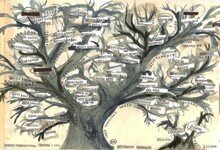Narrative Poems by Wakako Kaku

Body Becoming Zero by Wakako Kaku, from which the narrative poems presented here are taken, includes a comment by Shuntaro Tanikawa. He writes:
Ms Kaku is ambitious in pursuing poetry while story-telling has taken hold of her. I have long thought that story-telling and poetry don’t mix, but the poetry she pursues may manifest itself only in her stories. Her stories are somewhat different from prose in the ordinary sense, even though she starts them off with the details of everyday life.
Even if we adjust the line-breaks and punctuation of her narrative, it will still refuse to become a so-called short story. Her efforts are unique in the world of Japanese modern poetry, which is generally not good at epics or ballads. She often reads from her work, calling it “ei or recitation”, which reveals the unique source of her art. Her work is rooted, not in the world of poetry, but in the art of traditional Japanese story-telling.
Mr Tanikawa gets to the heart of Wakako Kaku’s narrative poems. Her narratives smoothly invite her readers into a world of story-telling that has been part of popular Japanese culture for many generations. Even now, in a corner of downtown Tokyo, story-telling artists in small theatres present popularly recognised classic pieces and new creations to young and old. On the stage, seated on a cushion, is a single story-teller who presents a tale with some gestures but practically no props. Naturally the text for this presentation is vernacular and rhythmic. Ms Kaku’s narrative style is clearly reminiscent of this type of narrative: filled with popular culture, replete with humour and sardonic irony, rhythmic and engaging.
Yet through her narrative, the reader/audience is taken beyond traditional story-telling into a unique realm of experience. Her narrative poems are invariably filled with the details of ordinary, everyday lives, mirroring the circumstances and times in which her protagonists live. Those simple details somehow converge into something extraordinary, culminating in an epiphany. While knowledge of Japanese culture is not required to appreciate these poems, I am providing some information on the topic that may be of interest to curious readers.
Ogre Inside
As the story opens, the omniscient narrator introduces us to a middle-aged housewife in the daily routine of eating her humble lunch alone. In the Japanese original the poet calls her ‘obasan’, a standard term for a woman who is no longer young, commonly used in greetings or descriptions in lieu of a proper name or a pronoun. Given the normal social circumstances in which the word obasan is used, it instantaneously communicates that the woman is middle-aged, unfashionable and utterly unremarkable. Unfortunately there is no equivalent English word for this. But the details provided in the poem sufficiently communicate what obasan, or the woman, is like.
The woman lives with her husband and their daughter, leading an eventless life in an ordinary neighborhood. The plainness of her life, her acceptance of it, and her boredom are real, but something is stirring beneath the calm.
She makes herself a cup of green tea as so many do day in and day out. A common Japanese belief has it that when a tea-stem floats upright in freshly poured tea, something good is going to happen. As the author notes for this translation, tea-stems are present only in inexpensive teas, because the higher-quality product consists only of carefully selected leaves with no stems.
The woman is cynical about this conventional belief: expecting her life to be eventless for the foreseeable future, she simply does not believe in a tiny omen of luck bringing something exciting. But suddenly Ogre appears, growing out of the tea-stem, the supposed good omen which she just dismissed. The woman, incredulous though she is, finds Ogre somehow familiar, and talks herself into accepting Ogre’s invitation to dance.
Oni, the Japanese word for Ogre, has been used for centuries, in contexts ranging from children’s games and folk or fairytales to serious literature. When Japanese children play hide-and-seek, the child who tries to find the others is called oni. Oni counts certain numbers, calls “Are you ready?” and starts looking for the hiding children when they softly answer “Ready!” In this poem, in order to pour a cup of tasty tea, the woman waits for “a voice from heaven” to say “Ready!” as if to release oni, although she has no idea that’s what she is waiting for.
Generally speaking, oni’s primary and fundamental characteristic is being supernatural and invisible. It presents itself only to those it chooses. Its appearance is larger than life, and awe-inspiring. Its nature can be divine, fearsome and punishing, or gentle and kindly. Illustrations often depict oni as a huge, red monstrous being dressed only in a loincloth, but there are blue oni as well. This word oni, in coined words or phrases, is also used to signify some inner force or energy that drives a person to achieve goals in various aspects in life. In relation to the arts, this drive can be both divine and demonic, and often proves to be destructive, even when the resulting work of art is sublime. The concept is universal, I believe, even though this divine/demonic drive may appear in a different form in a given culture.
Ogre’s first words to the woman are “the world will come to an end in seventy days”. When I was preparing to translate these poems, I asked the author about this prophecy. She told me that there is no specific significance to the number seventy beyond her feeling that it somehow fits comfortably in the narrative cadence, and she named Nostradamus in connection with the idea of the world coming to an end.
In mid 1970s a book entitled Nostradamus’s Great Prophecies sold millions of copies in Japan. This was the first of a series of fictions presented as if they were legitimate accounts of Nostradamus and The Prophecies. In one of these fictional accounts, Nostradamus predicted that the world would come to an end in July 1999. A disaster movie inspired by this best-seller was also released and became a great hit at the box office. Thus, the name Nostradamus and anxiety about facing the Millennium were lodged into Japan’s popular culture and psyche.
In this environment, the woman does not find Ogre’s dire prediction particularly surprising. It is part of the background of her daily life, including such notable contemporary Japanese fads as the green tea diet, the social dance boom, and breeding goldfish at home.
Once the woman allows herself to dance, Ogre liberates her inner energy so forcefully that after the dance she feels like “a tin can zapped by lightning”, referring to her former self. So she sets out to meet Ogre again to further liberate her latent inner energy. She becomes totally driven to pursue this path.
Her drive causes her daughter to ask the woman to dance for 300 children in the school gym. The woman dances in a white robe. Her partner Ogre is invisible to the audience. The release of her inner energy occurs with such force that she becomes “a simple dancing heart”, that “grew and grew endlessly/brimmed over the gym, exploded repeatedly/splashed into minute sparks of light”, and finally her inner truth is revealed to the children’s trusting eyes, in the form of the bright red Ogre. The moment of ultimate self-release is also the moment of total destruction of her own self, the children, and the whole world, fulfilling Ogre’s prophecy.
My Dear Ceramic Artist
“My Dear Ceramic Artist” is the soliloquy of the ghost of a young wife who met her unnatural death 49 days earlier. As noted in the translation, according to Buddhist rituals generally practiced in Japan, the memorial service on the 49th day marks an important juncture in the efforts of the living to send the soul of the deceased to the other world. Prior to this service, the dead soul is commonly believed to be adrift between this world and the other world.
After a successful 49th day memorial service for her benefit, she e-mails her husband a thank-you note (notice again the surprising use of the contemporary phenomena), which is this narrative poem. In this note she, as a ghost, speaks to her beloved husband, the ceramic artist, recounting her life with him and her pains and tribulations in this world, and the ultimate resolution she arrived at as a ghost.
The tone of her voice is polite, genteel and feminine. She is a chatty, gregarious, good-natured, non-artistic housewife, married to a man of few words who is intent on his pursuit of ephemeral beauty through ceramic art. They lived in two different worlds. Naturally this lovely young wife’s expectations of married life were disappointed, because her artist husband was totally devoted to his own creative pursuits. But as she, as a ghost, pesters the artist, clinging to him, she comes to realise that she is the artist’s source of inspiration, and the ephemeral beauty he pursues and finally achieves, in the form of an urn for her ashes, is dedicated to her soul. The story is simple, but moving. In this poem also, the central reality is the inspired pursuit of beauty, demonic or divine.
Steaming coffee image by George Dolgikh on Shutterstock







